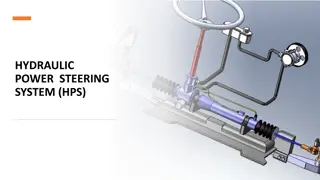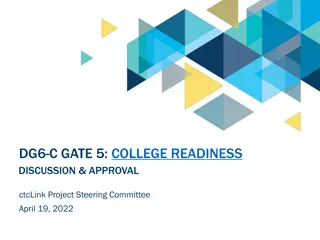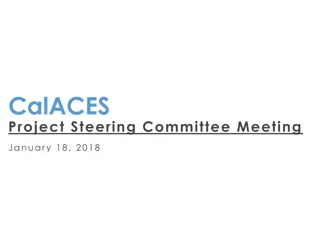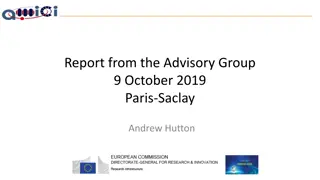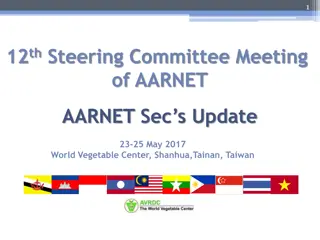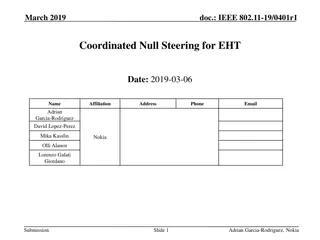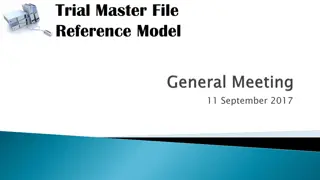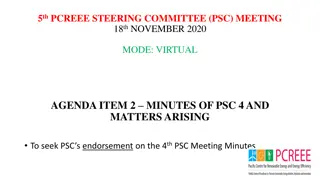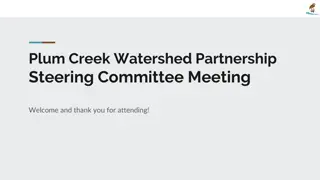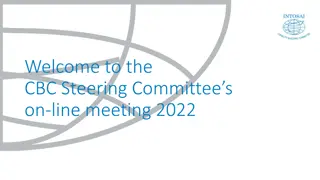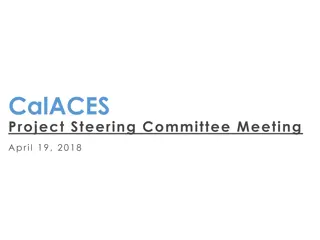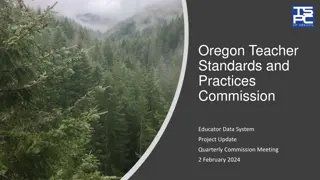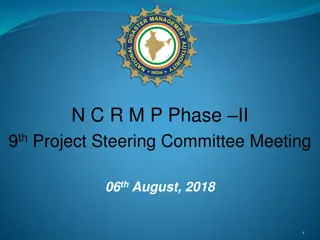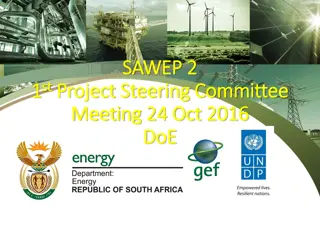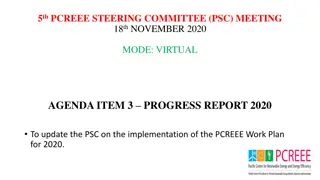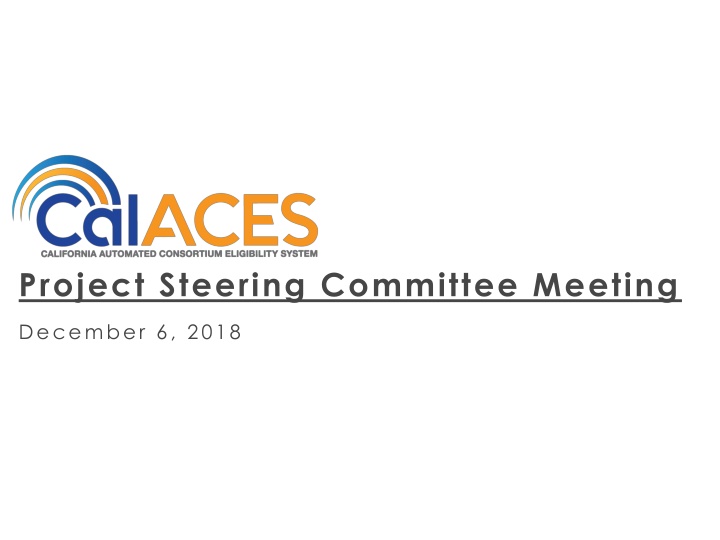
Project Steering Committee Meeting - December 6, 2018
Project Steering Committee Meeting held on December 6, 2018, covered various agenda items including approving meeting minutes, informational updates, and discussions on conversion objectives and processes. The meeting also announced the appointment of a new Region 7 PSC Representative.
Download Presentation

Please find below an Image/Link to download the presentation.
The content on the website is provided AS IS for your information and personal use only. It may not be sold, licensed, or shared on other websites without obtaining consent from the author. If you encounter any issues during the download, it is possible that the publisher has removed the file from their server.
You are allowed to download the files provided on this website for personal or commercial use, subject to the condition that they are used lawfully. All files are the property of their respective owners.
The content on the website is provided AS IS for your information and personal use only. It may not be sold, licensed, or shared on other websites without obtaining consent from the author.
E N D
Presentation Transcript
Project Steering Committee Meeting December 6, 2018
CalACES PSC Agenda 1) Call Meeting to Order 2) Agenda Review 3) Public opportunity to speak on items not on the Agenda 2
CalACES PSC Action Items 4) Approve the Minutes of the October 18, 2018 Project Steering Committee Meeting and review of Action Items 3
Announce the Appointment of the new Region 7 PSC Representative Yvonne Hawkes, Lassen County Program Manager
CalSAWS Conversion Approach Conversion Objectives and Process Record Retention Policy Discussion
C-IV Conversion to CalSAWS Objectives Minimize Downtime During Cutover Minimize Disruptions to County Staff Convert Previous EDBCs to Continue Benefits C-IV Conversion (to CalSAWS) Process C-IV Legacy Data Record Retention Conversion CalSAWS Open Programs Programs Closed w/in 4 years of Cutover All Time Limit Data Open Recovery Accounts Stage Legacy Data Transform Legacy Data Data Confirmation Execute Data Discrepancy Reports Execute Functional Tests
HISTORY: ISAWS Conversion to C-IV Converted: The authorized benefit amount from ISAWS to roll benefits amounts (in C-IV) for converted cases until EDBC is ran 14 months of Historical Data for all Open Cases 13 months of Historical Data for all Cases Closed w/in the 4 Months Leading up to the Cutover Recovery Accounts with a balance other than 0 into C-IV Cutover Window: Began on Thursday evening with Legacy System running Batch programs and Extracting Data Both Legacy (ISAWS) and Source (C-IV) Systems were Down for one business day (on Friday) Conversion Processes executed over the Weekend C-IV System was Up by Monday morning with the ISAWS data converted and respective Conversion Reports provided to County Staff Day 1 Friday Day 2 Saturday Day 3 Sunday
HISTORY: LEADER Conversion to LRS Converted: The authorized benefit amount from LEADER to roll benefits amounts (in LRS) for converted cases until EDBC is ran 3 years of Historical EDBC Data for all Open Cases and Cases Closed w/in the 3 years Leading up to the Cutover All Closed Cases with Active Recovery Accounts or Investigations Closed Cases greater than 3 years converted as Shell Cases with Time Limit data Cutover Window: Began on Friday evening with Legacy System running Batch programs and Extracting Data. Conversion Processes executed over the Weekend and into Monday (both LEADER and LRS Down for one business day). LRS System was Up by Tuesday morning with the LEADER data converted and respective Conversion Reports provided to County Staff. Day 1 Saturday Sunday Day 2 Day 3 Monday
CalWIN Conversion to CalSAWS Record Retention and Converted Data: Work with the CalWIN to confirm Data Mappings to CalSAWS Targeted Fields (in an effort) to meet agreed upon Conversion Objectives. For example: Develop Strategies to Minimize Downtime During Cutover Window Minimize Business Disruptions to County Staff Convert Previous EDBCs to Continue Benefits Cutover Window: Day 1 Day 2 Day 3
Data Retention Policy General Policy In general, with some exceptions, policy states data can be retained until three years (36 months) after case closure. Federal law requires records used as the basis for fiscal claims must be retained for three years (36 months) from the date when the state submits its final expenditure report to the Dept of Health and Human Services (DHHS). MPP Section 23-353.6 further clarifies that, for the general case, a retention period of three and one-half years (42 months) is considered to meet the federal reporting requirement. Manual of Policies and Procedures (MPP), Section 23-353, Introduction: Federal law (45 CFR 74.20) requires that case records which provide the basis for fiscal claims are to be retained for three years, starting on the day the state submits the last expenditure report to HHS for the period. In the case of supplemental expenditure reports this might require retention for a much longer period than three years. Manual of Policies and Procedures (MPP), Section 23-353.6: Unless a county has made or intends to make a supplemental expenditure report concerning specific cases which it wishes to purge or destroy, it may consider the retention period to be 3-1/2 years from the date a document was last needed to document eligibility or 3-1/2 years from the date the case was closed.
Exceptions Time Limit Data This data must be retained for the lifetime of the individual. Not safe to assume WDTIP is permanent system of record for time limit data Conclusion: Retain all Time Limit data. Recovery Accounts still subject to collections Data must be retained until County no longer wishes to pursue collection activity on the account. Conclusion: Retain all cases associated with an open recovery account.
Exceptions Warrant Registers Retain for 5-15 years Not associated to specific cases Conclusion: Retain all Warrant Registers. Criminal and Litigation-Related Records Retain indefinitely, until all legal actions are concluded Conclusion: As a starting point, look at retaining all cases associated with a special investigation record. Foster Care, Kin-Gap, and Adoptions Assistance cases Various policies (e.g., ACL 11-15 for KG) point to indefinite retention for cases associated to these programs Conclusion: Retain all of these cases, regardless of status
What to Retain Retain shell of all cases. This would contain the following: High-level information about persons associated to the case, including Name, DOB, SSN, CIN. Case Name Serial Number Time Limit Data
What to Not Retain A non-exhaustive list: Case data Program data EDBC data Journal Benefit History Financial/Non-Financial data for people (assuming they are only associated to cases not being retainined) Tasks Recovery Accounts Correspondence Verifications
Number of cases affected (in C-IV, as of 11/5) For C-IV data, if we use the rules mentioned (extending the 42 months to 48 months), approximately 2/3 of cases would be retained. Total Cases: 6,154,954 1,977,321 (32%) 4,177,633 (68%)
CalACES PSC Status of Cloud Proof of Concept What are the Objectives of the Cloud Proof of Concept (PoC)? Determine viability of CalSAWS in the cloud from a cost, performance, and availability standpoint Document blueprints of as-built infrastructure Develop a roadmap for changes to enable CalSAWS in the cloud The PoC does not end with a cutover to the cloud it ends with a plan for a process to safely and securely transition to the cloud. 18
CalACES PSC Status of Cloud Proof of Concept How are we proving the concept of CalSAWS in the AWS Cloud? 19
CalACES PSC Status of Cloud Proof of Concept What have we learned from the PoC so far? 20
CalACES PSC Status of Cloud Proof of Concept How is the Cloud Roadmap structured? C-IV Cutover CalSAWS LRS Development CalWIN Cutovers Phase 1: Changes Required for LRS and move LRS to the Cloud Phase 2: Changes Required for 40/58 County Scaling Phase 3: Take Advantage of Advanced Cloud Features 21
CalACES PSC Status of Cloud Proof of Concept What are the next steps for cloud/PoC? Continue testing performance at greater scale Create the roadmap based on findings found during the PoC Develop a change order for the Migration project based on the roadmap o Consortium will contract with 3rd parties for required infrastructure o Consortium will agree on scope of work with Accenture for changes required to enable LRS/CalSAWS in to the cloud Execute a methodical process to safely move LRS/CalSAWS to the cloud 22
CalACES PSC Governance Education Webinars Webinar Informational Sessions: The goal of these sessions is to provide an overview of the JPA structure and to review changes to the existing JPA Agreement, Bylaws and MOU. There are three sessions scheduled. Counties may attend any session as the information shared will be identical. However, counties are encouraged to attend with their current consortium affiliations as noted below: November 29, 2018 from 10:00 a.m. to 11:30 a.m. CalACES Consortium December 13, 2018 from 10:00 a.m. to 11:30 a.m. WCDS Counties December 20, 2018 from 10:00 a.m. to 11:30 a.m. Make up Session for all Counties Who should attend: It is strongly encouraged that all counties participate including the Director and County Counsel. Reference: CRFI 18-011 Draft version of updated Joint Powers Authority (JPA) Agreement, Memorandum of Understand (MOU), and Bylaws were distributed for review. CIT 063-18 Webinar Sessions Announced 24
CalACES PSC Governance Education Webinars Next Steps Begin as-needed conference calls of Attorney Working Group Presentation of revised governance documents at California Health and Welfare Attorney Committee meeting (November 15) Webinars/teleconferences for Directors, Staff and County Counsels (November- December 2018) Comments from Counties no later than December 21 to allow for final review by Attorney Working Group Final revisions to governance documents, in consultation with the Leadership Team (December 2018) Revised governance documents go to CalACES Member Representatives and Board for approval (January 25, 2019) Final JPA and MOU distributed to Counties for action by Boards of Supervisors (by January 31, 2019) County approval process completed, executed JPA and MOU documents received by Consortium (May 15, 2019) Joint Board and Member Representative meeting (WCDS Counties included at meetings) Current Member Representatives concur in new JPA and Bylaws Current Board approves new JPA, Bylaws, MOU Board elections by newly constituted Regions, to take effect July 1, 2019 (June 28, 2019) Effective Date for revised JPA, Bylaws, MOU (July 1, 2019) 25
CalACES PSC Contact Center Requirements Gathering Contact Center Requirements Gathering Update The goal of these sessions is for attendees to participate in a walkthrough of the C-IV centralized system functionality and review associated requirements and/or identified functionality gaps. The CalSAWS Contact Center Requirements Gathering session will consist of a one-day session, beginning at 9:30 a.m. and ending at 4:30 p.m. on December 12, 2018. Lunch will not be provided; however, there is a cafeteria onsite. The session will take place in Roseville at the CalWIN/Hewlett Packard site in the Garden Suites. There is no registration fee for the session. Reference - CRFI 18-014 26
CalACES PSC Proposed Migration of 39 Counties Contact Center to Amazon Connect The project is proposing Amazon Connect as the next generation for the 39 counties contact center solution. KEY DRIVERS KEY ADVANTAGES The contact center solution for 39 counties is currently due for a hardware/software refresh. By reallocating resources currently earmarked for upcoming SCR s related to the Cisco refresh; this can result in reducing the level of effort required for migrating to an Amazon connect solution. This solution would result in future cost savings for the 39 counties contact center solution as well as provide a platform for future innovation & enhancements. 100% CLOUD BASED CONTACT CENTER AS A SERVICE MODULAR & SCALABLE SECURE & RELIABLE PAY AS YOU GO Cisco Cisco Amazon Connect Amazon Connect Next Steps Task / Milestone Tentative Timeframe Schedule time with 14 Contact Center Counties December 2018 Visit all 14 Contact Center Counties December 2018 Present solution to PSC February 2019 Project Kick off March 2019 28
Review Procurements OCAT QA Other Upcoming
CalACES PSC OCAT Procurement Overview Goal is to re-platform the existing OCAT functionality Integrate the re-platformed OCAT with the SAWS Eliminate duplicate data entry and data redundancy Currently OCAT workgroup is reviewing and finalizing the RFP package All comments formally responded to with disposition noted Procurement assistance from Los Angeles County DPSS, Betty, and Dave Procurement will be run through the San Bernardino ePro system and Purchasing Department 30
CalACES PSC OCAT Procurement Update Key Milestones OCAT RFP Release Date Friday, Dec 14 Vendors Conference Monday, Jan 7 Proposal Due Date Friday, Feb 8 Proposal Evaluation Monday, Feb 11 Thursday, Mar 28 Orals/Key Staff Interviews Tuesday, Feb 19 Friday, Feb 22 Prepare Vendor Selection Report Friday, Mar 29 Monday, Apr 8 Vendor Selection Report Review & Approval Tuesday, Apr 9 Thursday, Apr 18 Release Notice of Intent Friday, Apr 19 Negotiations & Approvals Monday, Apr 22 Tuesday, Jun 4 OCAT Vendor Start Date Monday, Jun 10 31
CalACES PSC CalSAWS QA Procurement QA vendor for CalSAWS DD&I and M&O Completed review by State partners Currently in review with Federal partners Submitted November 2, 2018 Planning on in-person and webinar bidders conference Not using ePro for submission Using OSI facilities and SharePoint 32
CalACES PSC CalSAWS QA Procurement Key Milestones QA RFP Release Date Friday, Dec 14 Vendors Conference Monday, Jan 7 Proposal Due Date Friday, Jan 25 Proposal Evaluation Monday, Jan 28 Wednesday, Mar 6 Orals/Key Staff Interviews Wednesday, Feb 27 Friday, Mar 1 Prepare Vendor Selection Report Thursday, Mar 7 Tuesday, Mar 19 Vendor Selection Report Review & Approval Tuesday, Mar 19 Friday, Mar 22 Release Notice of Intent Monday, Mar 25 Negotiations & Approvals Tuesday, Mar 26 Thursday, May 30 QA Vendor Start Date Monday, Jun 3 33
CalACES PSC Upcoming Potential Procurements CalWIN OCM, Training and Implementation Support CalSAWS Contact Center Consolidated Portal/Mobile App FCED Procurement Vendor for CalSAWS 58-County M&O Procurement CalSAWS 58-County M&O Procurement 34
2018 CalACES Conference Debrief HMIS Can we add statewide tracking for homeless services/needs? Request for Foster Care Summit Suggestion CalFresh should be its own committee
County Design Input Refer to handouts: Draft CalACES CDI Project Process.docx Draft CalACES County Design Input Process.docx
CalACES SCR Approach CalSAWS Status and Next Steps Status Completed the roll out of the updated SCR approach to the Project Staff by October 17, 2018 Conducted two SCR Overview webcasts for PPOCs, all committees, Workgroups and RPMS on November 13, 2018. Approximately 400 participants called into the webcast. The updated SCR approach was effective November 1, 2019. The remaining process to be rolled out is the formal County Design Input process. Drafted the County Design Input process. Expected rollout in January 2019. Upcoming: Continue to monitor and review the anomalies to the SCR scorecards Add County Request for Policy Clarification (CRPC) tracking in JIRA SCR Tracking Tool Update M&O Handbook Drafted County Design Input Project Process Drafted County Input Process
SPG Scorecard Update SPG scorecard six month pilot was rolled out in August of 2018. Since August, The following SCRs have been approved through SPG with scorecard results in the following priorities: CalACES North (82 SCRs): 22 Critical 30 High 25 Medium 5 Low CalACES South (109 SCRs): 31 Critical 56 High 22 Medium 0 Low In Progress - QA process to review the responses to questions and results of the scorecard.
SPG Scorecard Calculation Breakdown 3 Main Sections to the SPG Scorecard: 1. Change Request Information 3 questions Each question weighted equally at 33% (3 questions x .33 = 1.00) Section has a 20% overall weighted score 2. Business Impact 5 questions Each question weighted equally at 20% (5 questions x .20 = 1.00) Section has a 50% overall weighted score 3. Migration Impact 1 question 1 question weighted at 100% (1 question x 1.00 = 1.00) Section has a 30% overall weighted score SPG Scorecard Priorities & Score Ranges: SPG Scorecard Priorities Min Range Max Range Priority Definitions Work stoppage will occur and no alternative procedure exists OR Regulatory, Program Directive or Contractual Requirements will not be met. High impact to Caseload and/or Workers OR Alternative Procedure requires excessive time, cost and/or resources. Moderate impact to Caseload and/or Workers OR Alternative Procedure requires some increase in time, cost and/or resources. 85 100 Critical 70 84 High 45 69 Medium Minimal impact to Caseload and/or Workers OR Alternative Procedure in place with minimal time, cost and/or resources. Also considered nice to have and are useful to pad out a release. 0 44 Low
SPG Scorecard Calculation Breakdown MIGRATION IMPACT ASSESSMENT CHANGE REQUEST INFORMATION BUSINESS IMPACT ASSESSMENT (1) How many Counties are impacted by the Requested Change? o 0 (20) o 1 (40) o 2 20 (60) o 21 39 (80) o 40 (100) 1) Change Request Type: o DSR (County) (0) o Individual Data Change (15) o Data Change (30) o Enhancement (45) o Operational (60) o Policy Re-design (75) o New Policy (100) (1) What is the Migration Impact on the Requested Change? o Introduces a Significant Design Difference (15) o Introduces a Minor Design Difference (30) o No Impact - County/System Specific (45) o Partially Closes a Design Difference (60) o No Impact Targeted for same release in C-IV/LRS (75) o Closes a Design Difference (100) (2) Does the requested change directly impact benefits provided to Recipients? o No (20) o Yes (100) (2) Reason for Request: o Other Please Specify (0) o County Specific Policy or Request (20) o Operational Necessity (40) o New Policy/Policy Redesign (60) o Committee Priority (80) o JPA/PSC Strategic Initiative (100) (3) Approximate population impacted by this change request. o 0 500 (20) o 501 2,000 (40) o 2,001 10,000 (60) o 10,001 50,000 (80) o 50,000+ (100) (3) Potential Risk if not Implemented Timely: o None (0) o Resource Efficiency (15) o System Performance (30) o Potential Litigation (45) o In Litigation/Court Judgment (60) o Impact to Customer (75) o Increased Error Rates (100) (4) Can the change be handled through a reasonable alternative procedure, business process change or training? o Yes (20) o No (100) (5) What is the estimated Effective Date: o Not Applicable (0) o Over a Year from Now (20) o In 7 12 Months (40) o In 4 6 Months (60) o In 0 3 Months (80) o Past Due (100)
SPG Scorecard Example Example 1: Top Score 100 Weighting Average Calculation Change Request Info (20%) Normalized Score Value Entered New Policy JPA/PSC Strategic Initiative Line Item Score 100 100 Section % Multiplier 33% 33% Section Score 33 33 Change Request Type Reason for Change Request Increased Error Rates 100 33% 33 Potential Risk if not Implemented Timely 300 100% 100 20 Total Business Impact (50%) Value Entered 40 Yes 50,000+ No Past Due Section % Multiplier 20% 20% 20% 20% 20% 100% Section Score 20 20 20 20 20 100 Normalized Score Line Item Score 100 100 100 100 100 500 Counties Impacted Benefits Population Impacted Alternative Procedure Effective Date 50 Total Migration Impact (30%) Section % Multiplier Value Entered Line Item Score Section Score Normalized Score Closes a Design Difference 100 100% Design/Implementation 100 100% 100 30 Total Total Score: 100 Priority: Critical
SPG Scorecard Example Example 2: SCR CA-57452/CIV-10892: ACWDL 17-32 -ACWDL 17-32 - Add new Medi-Cal NOA fragments for Failure to Respond Weighting Average Calculation Normalized Score Change Request Info (20%) Value Entered Policy Re-design New Policy/Policy Redesign Increased Error Rates Line Item Score Section % Multiplier 75 60 45 180 Section Score 25 20 15 60 33% 33% 33% 100% Change Request Type Reason for Change Request Potential Risk if not Implemented Timely 12 Total Normalized Score Business Impact (50%) Value Entered Section % Multiplier Section Score Line Item Score 40 20 100 100 100 360 1 20% 20% 20% 20% 20% 100% 8 4 20 20 20 72 Counties Impacted Benefits Population Impacted Alternative Procedure Effective Date No 50,000+ No Past Due 36 Total Normalized Score Migration Impact (30%) Section % Multiplier Value Entered Line Item Score Section Score No Impact - Targeted for same release in C-IV/LRS 75 100% Design/Implementation 75 100% 75 23 Total Total Score: 71 Priority: High
Frequency of Workgroup Meetings How many times have the workgroups met in the last year? Does tight coupling make sense for DCFS SCRs?
SFY 17/18 CalHEERS Interface Cost Claiming Issue Update
M&O Application & Policy Update SSI Cash Out (Funding) Change Reason
Policy Implementation Item Policy Effectiv e Date C-IV Status LRS Status Description CalACES Implementation Effort Funding for Emergency Caregivers with Placement of Children and Non- Minor Dependents prior to Resource Family Approval 7/1/2018 SCR 102237 SCR 204665 Per ACL 18-33, all counties were required to provide the Short-Term, Interim payment (AB 110) to caregivers who had taken placement of a child prior to completing the Resource Family Approval (RFA) process between 3/30/18 and 06/30/2018. Implemente d Implemente d Effective July 1, 2018, all counties must provide a payment equivalent to the basic level rate for a resource family to the Emergency Caregiver (EC) of a child. However, unlike the Short-Term, Interim funding, the EC funding will be exclusively funded through the Emergency Assistance (EA) Program, aid code 5K. Release Release 18.11 18.11 SCR 101497 SCR 203634 CalACES Update: A Good Cause section is being added to the Foster Care License/Home Approval page New automated tasks to track Good Cause are being added Emergency Assistance (EA) fields are being added to the Foster Care Placement Authority Probation Court Order Two Pay Codes added in the Phase II SCR are being automated A new approval and discontinuance notice is being added to the template repository. ACL 18-75 System Test System Test Release Release 19.01 19.01 48
Policy Implementation Item Policy Effective Date C-IV Status LRS Status Description CalACES Implementation Effort CalFresh Ending Cash Out for SSI/SSP Recipients Policy 5/20/2019 SCR 101471 SCR 203103 The Legislative budget bills include agreement to fund the SSI (Supplemental Security Income) Cash Out initiative which would reverse California s current law that prohibits SSI and/or SSP (State Supplementary Payment) recipients from receiving CalFresh benefits. This policy contains several components which will be implemented no later than August 1, 2019. Design Design Release 19.05 Release 19.05 Ending Cash Out applies to three groups of individuals and/or households: ACL 18-90 Group 1 SSI/SSP beneficiaries who are new CalFresh applicants who will no longer be precluded from CalFresh eligibility, as well as current CalFresh households who have an SSI/SSP member(s) who will be added to the case. ACL 18-91 ACL 18-92 Group 2 Supplemental Nutrition Benefit (SNB) program: CalFresh households who have an excluded SSI/SSP member and as a result of this policy will experience a reduction in the CalFresh allotment once the SSI/SSP member and their income are added to the CalFresh household budget. Group 3 Transitional Nutrition Benefit (TNB) program: CalFresh households who have an excluded SSI/SSP member and as a result of this policy will lose their eligibility to CalFresh benefits once the SSI/SSP member and their income are added to the CalFresh household budget. The legislature has agreed to hold these households harmless by supplementing their benefits via a new state-only program. - Continued on next slide - 49
Policy Implementation Item Policy Effective Date C-IV Status LRS Status Description CalACES Implementation Effort CalFresh Ending Cash Out for SSI/SSP Recipients Policy 5/20/2019 SCR 101471 SCR 203103 CDSS published ACLs 18-90, 18-91, and 18-92 on July 31, 2018. Design Design On August 13, 2018, CDSS kicked off the Reversing SSI Cash-Out Automation meetings. This group includes CDSS, CWDA, SAWS and the counties. The purpose of these meetings are to discuss questions related to the policy, implementation strategy, and automation timeline. These meetings are held bi-weekly through October at the CalACES North location. Release 19.05 Release 19.05 ACL 18-90 CalACES Update: System changes for this effort will include: Update eligibility rules to determine SSI individuals eligible to CalFresh if they meet CalFresh eligibility requirements Add eligibility rules to determine the Supplemental Nutrition Benefit and the Transitional Nutrition Benefit Add the appropriate Notices of Action ACL 18-91 ACL 18-92 The SSI Cash Out SCR and design document was sent to the CW/CF Committee on 11/9/18. The Project met with the CW/CF Committee several times to review and discuss the SCR design before giving final SCR approval on 11/30/18. 50


